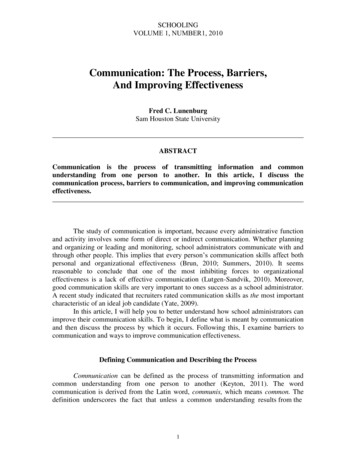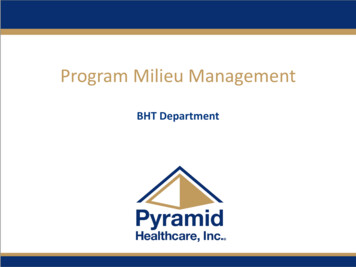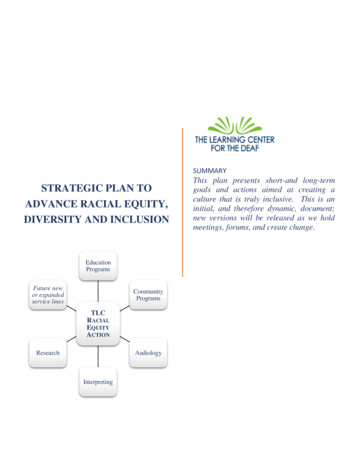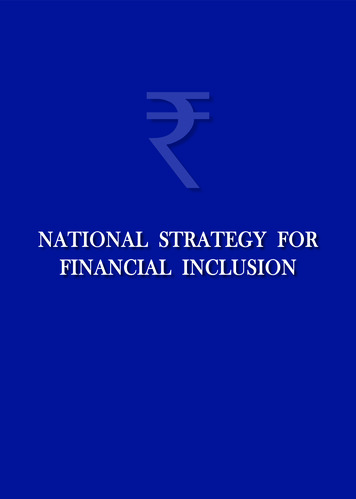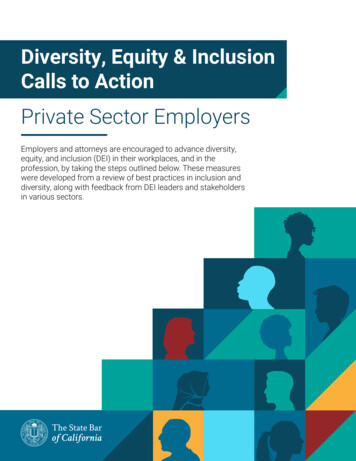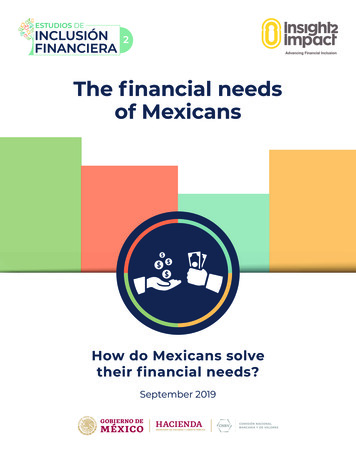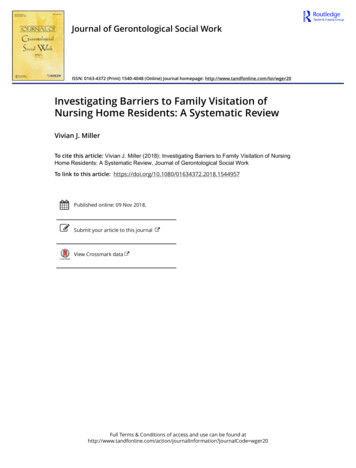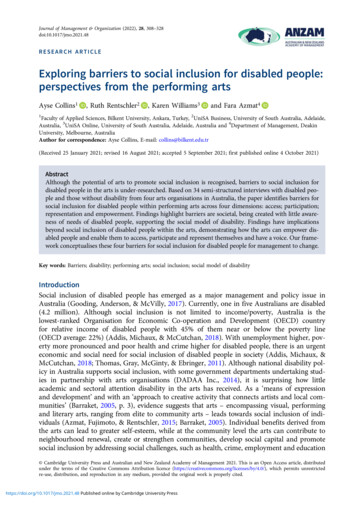
Transcription
Journal of Management & Organization (2022), 28, 308–328doi:10.1017/jmo.2021.48RESEARCH ARTICLEExploring barriers to social inclusion for disabled people:perspectives from the performing artsAyse Collins1, Ruth Rentschler2, Karen Williams3and Fara Azmat41Faculty of Applied Sciences, Bilkent University, Ankara, Turkey, 2UniSA Business, University of South Australia, Adelaide,Australia, 3UniSA Online, University of South Australia, Adelaide, Australia and 4Department of Management, DeakinUniversity, Melbourne, AustraliaAuthor for correspondence: Ayse Collins, E-mail: collins@bilkent.edu.tr(Received 25 January 2021; revised 16 August 2021; accepted 5 September 2021; first published online 4 October 2021)AbstractAlthough the potential of arts to promote social inclusion is recognised, barriers to social inclusion fordisabled people in the arts is under-researched. Based on 34 semi-structured interviews with disabled people and those without disability from four arts organisations in Australia, the paper identifies barriers forsocial inclusion for disabled people within performing arts across four dimensions: access; participation;representation and empowerment. Findings highlight barriers are societal, being created with little awareness of needs of disabled people, supporting the social model of disability. Findings have implicationsbeyond social inclusion of disabled people within the arts, demonstrating how the arts can empower disabled people and enable them to access, participate and represent themselves and have a voice. Our framework conceptualises these four barriers for social inclusion for disabled people for management to change.Key words: Barriers; disability; performing arts; social inclusion; social model of disabilityIntroductionSocial inclusion of disabled people has emerged as a major management and policy issue inAustralia (Gooding, Anderson, & McVilly, 2017). Currently, one in five Australians are disabled(4.2 million). Although social inclusion is not limited to income/poverty, Australia is thelowest-ranked Organisation for Economic Co-operation and Development (OECD) countryfor relative income of disabled people with 45% of them near or below the poverty line(OECD average: 22%) (Addis, Michaux, & McCutchan, 2018). With unemployment higher, poverty more pronounced and poor health and crime higher for disabled people, there is an urgenteconomic and social need for social inclusion of disabled people in society (Addis, Michaux, &McCutchan, 2018; Thomas, Gray, McGinty, & Ebringer, 2011). Although national disability policy in Australia supports social inclusion, with some government departments undertaking studies in partnership with arts organisations (DADAA Inc., 2014), it is surprising how littleacademic and sectoral attention disability in the arts has received. As a ‘means of expressionand development’ and with an ‘approach to creative activity that connects artists and local communities’ (Barraket, 2005, p. 3), evidence suggests that arts – encompassing visual, performingand literary arts, ranging from elite to community arts – leads towards social inclusion of individuals (Azmat, Fujimoto, & Rentschler, 2015; Barraket, 2005). Individual benefits derived fromthe arts can lead to greater self-esteem, while at the community level the arts can contribute toneighbourhood renewal, create or strengthen communities, develop social capital and promotesocial inclusion by addressing social challenges, such as health, crime, employment and education Cambridge University Press and Australian and New Zealand Academy of Management 2021. This is an Open Access article, distributedunder the terms of the Creative Commons Attribution licence (https://creativecommons.org/licenses/by/4.0/), which permits unrestrictedre-use, distribution, and reproduction in any medium, provided the original work is properly cited.https://doi.org/10.1017/jmo.2021.48 Published online by Cambridge University Press
Journal of Management & Organization309in deprived communities (Azmat, Fujimoto, & Rentschler, 2015). Furthermore, the arts ‘comfortin times of trouble’, heal, inspire community participation and foster a compassionate society(Chew, 2009, p. 9). However, social inclusion and its subsequent benefits are beset by barrierswhich may be unequally distributed and/or unattainable for some disabled people, a topicwhich has received limited academic attention. Management implications include changes in policy and praxis that entail taking an integrated approach to disabled people focusing on multiplelevels (Syed & Kramar, 2009), as described later in this paper. Within this context, this paper aimsto examine barriers to social inclusion of disabled people in the performing arts. For the purposeof the paper, we define disabled people as those with physical, cognitive or intellectual disability.Although management scholars have examined social inclusion in relation to Indigenousartists (Congreve & Burgess, 2017) and disabled people in community organisations(Fujimoto, Rentschler, Le, Edwards, & Härtel, 2014), the management perspective has receivedless attention with respect to disabled people in the arts. Accordingly, this paper fills this gapin the management literature by examining barriers that disabled people face in relation totheir social inclusion in the arts, with regards to four dimensions: access (Gidley, Hampson, &Wheeler, 2010; Kawashima, 2006; Kusayama, 2005), participation (Evans, Bellon, & Matthews,2017; Gidley, Hampson, & Wheeler, 2010; Kawashima, 2006; Putnam, 2000), representation(Kawashima, 2006; Lindelof, 2015) and empowerment (Evans, Bellon, & Matthews, 2017;Gidley, Hampson, & Wheeler, 2010; Themudo, 2009; vom Lehn, 2010). We answer the followingresearch question: What are the barriers to social inclusion for disabled people in the arts?We use a qualitative study of semi-structured interviews to examine the question using the lensof the social model of disability. We interview disabled people who are actively involved in theperforming arts, namely disabled audiences, carers, disabled artists in performing arts and peopleworking in performing arts organisations such as artists and administrators as well as advocates,executives and board directors. Such diversity in participants enabled us to examine challenges insocial inclusion in the performing arts.The study contributes towards expanding knowledge about barriers to social inclusion of disabled people in the performing arts by bringing together and analysing four dimensions of socialinclusion that have not previously been examined holistically. Furthermore, using the voices ofdisabled people and other stakeholders, it develops a framework for management to better understand and conceptualise inclusion issues facing disabled people and identify key barriers to theirsocial inclusion, which is timely given the under-researched nature of the topic. The framework(see Figure 1) thus provides a starting point for change leading to workplaces becoming bettersuited to maximising the inclusion of disabled people and could be applied for inclusion of people from other disadvantaged backgrounds as well as migrants or refugees. The framework alsocontributes to facilitating academic discussion about social inclusion/exclusion of disabled peopleand other disadvantaged members in workplaces. Although the framework is developed based ona study in the Australian context, its findings could be generalised to other nations seeking to understand barriers to social inclusion for disabled people as a means of seeking to overcome them.The rest of this paper is structured in the following way. We start by discussing the socialmodel of disability to provide the theoretical underpinning of our study. Next, we provideinsights into different interpretations of social inclusion and its four dimensions (access, participation, representation and empowerment) followed by an examination of how arts can facilitatesocial inclusion. This is followed by a discussion of our methodology, the findings, the empiricalmodel and the theoretical and managerial implications of the study.Literature reviewSocial model of disabilityTo further understandings of barriers faced by disabled people within the performing arts, thispaper draws upon the social model of disability – a model that focuses on societal structureshttps://doi.org/10.1017/jmo.2021.48 Published online by Cambridge University Press
310Ayse Collins et al.Fig. 1. Access, participation, representation and empowerment (APRE) framework of barriers to social inclusion.rather than individual impairment (Woods, 2017, p. 1094). The social model recognises/makesthe crucial difference between impairment and disability (Oliver, 1990). Within this model,impairment is defined ‘in relation to a species norm in terms of functional ability’ (Chapman,2020, p. 218) or ‘loss’ in some ability that is assumed to be common to humans with impairmentsthemselves’ (Rosqvist, Chown, & Stenning, 2020, p. 5). It considers disability to be societal failure,failing to accommodate and accept impaired individuals (Oliver, 1990). People are disabled byableist structures, both physical and attitudinal (Rosqvist, Chown, & Stenning, 2020, p. 5).Rather than an individual issue, the social model emphasises ‘material factors, social relationsand power structures that exclude people with a disability’ (Verhaeghe, Van der Bracht, & Vande Putte, 2016, p. 234). As argued by Oliver (1990, p. 33), this includes:all the things that impose restrictions on disabled people; ranging from individual prejudiceto institutional discrimination, from inaccessible public buildings to unusable transport systems, from segregated education to excluding work arrangements.The social model, hence, argues for the removal of these barriers and has been accompanied by asocial movement designed to politically address the social exclusion of disabled people(Verhaeghe, Van der Bracht, & Van de Putte, 2016, p. 234). Within the social model it is thelived experience that is essential to further understanding and research of the barriers toindependence and equality (Rosqvist, Chown, & Stenning, 2020, p. 5).The social model offers a ‘simple, memorable and effective’ idea (Shakespeare, 2006, p. 199).This simplicity makes it easy to explain and presents a ‘clear agenda for social change’(Shakespeare, 2006, p. 199). However, as noted by Shakespeare (2006, p. 200), the model’s simplicity is also its weakness. For example, a limitation of the social model is that it fails to identifyimpairment. Shakespeare pointed out that as early as 1992 Crow had argued that disabled peoplecannot simply pretend that their impairments are irrelevant (cited in Shakespeare, 2006, p. 200).For many disabled people their impairment is an important aspect of their lives and once theterm ‘disability’ is located and understood as a form of ‘oppressive social reactions’ placedupon the impaired, ‘there is no need to deny that impairment’ or that ‘in many situationsboth disability and impairment effects interact to place limits on activity’ (Thomas, 2004, p. 29).A second important limitation noted by Shakespeare (2006, p. 201) is the concept of a ‘barrierfree Utopia’. Put simply, a world in which people with impairments are no longer disabled bybarriers is hard to operationalise. For example, the sights and sounds of musical theatre willremain inaccessible for those lacking sight or hearing. Moreover, in some situations, differentaccommodations are incompatible with different impairments or indeed those with the sameimpairment may require different solutions (Shakespeare, 2006, p. 201). To highlight this,some individuals impaired by blindness may require Braille while others require large print oraudio files (Shakespeare, 2006, p. 201). As such, in some situations, environmental changehttps://doi.org/10.1017/jmo.2021.48 Published online by Cambridge University Press
Journal of Management & Organization311remains impossible, while in others, feasibility and resource constraints make other arrangementsmore practical (Shakespeare, 2006, p. 201).Despite these limitations, services can and should be adapted wherever possible (Shakespeare,2006, p. 202). The social model thus serves as a ‘practical tool’ rather than theory, idea or concept(Oliver, 2004, p. 30). From a management perspective, understanding barriers to social inclusionfrom the social model lens is important as it offers insight into the barriers faced by disabled people at both an organisational and societal level. Embedded in our argument is the premise that formanagers to be effective agents for social inclusion they must understand disabled people beyondpolicy and the individual, by examining how people are disabled by societal factors. As such, thispaper, drawing upon disabled stakeholders within the performing arts, offers a social inclusionframework to help further understand organisational and societal issues facing disabled people.Social inclusionSocial inclusion ensures that everyone in society has opportunities, capabilities and resources toenable them to contribute to and share in the benefits of community or national development(Cultural Minister’s Council, 2009). It has been argued that social inclusion can be achievedby taking actions to reach a moral imperative: leave no one behind and avoid the potential economic and social costs of exclusion (Report on the World Social Situation, 2016). Social inclusionis, therefore, seen as the process of providing opportunities to include people from all backgrounds, ensuring that they have the resources, opportunities and capabilities to work, learn,engage and have a voice (Australian Social Inclusion Board, 2012). Similarly, Barack (2010)sees social inclusion as provision of an equal opportunity platform for minority members to participate fully in all socio-economic activities.Social inclusion and its dimensionsSocial inclusion has no single definition, being interpreted in diverse ways. For this paper, wedefine social inclusion as a process with four interlocking dimensions in which everyone feelsvalued and has the opportunity to participate, for example, through performances, programmesor events, whether or not they have a disability. These four dimensions have been identified byscholars, but the four of them have not been discussed in a holistic manner, as far as the authorscould determine. The next section provides a brief assessment of each dimension and its relationship to the arts. Although we analyse them separately, we recognise that there may be overlap inthese dimensions.AccessAccess was first discussed in the UK during the 1970s and 1980s as part of the review of museumpolicy at the government level. The aim was to open cultural activity to a wider sector of people asaudiences, according to Ames (1985), one of the earliest advocates.In 1998, Sandell expanded this concept to the realm of social inclusion by suggesting that barriers to access of museums ‘be removed by changing, for example, the ambience of the building,signage and the language used in displays’ (Kawashima, 2006, p. 58). Access continued to be aconcept mainly related to museums well into the 21st century. Kawashima (2006) discussed progress made over time with an economic focus, accounting for the decision to make museums andgalleries free. Thus, financial barriers were eliminated, making museums open to all classes.Taylor and Bogdan (1989), early proponents of social inclusion for disabled people, said thataccess can be increased by interaction between those with and without disability. Their focuswas the mentally challenged in the USA, while Kusayama was concerned about inclusion forthe visually impaired in Japan. He found that accessible facilities for people with mobility difficulties are more advanced compared with those who have sensory difficulties (2005, p. 877). Thishttps://doi.org/10.1017/jmo.2021.48 Published online by Cambridge University Press
312Ayse Collins et al.paper is different in that it represents all disabilities, moves the location from museums to performing arts and deals with disabled people as audiences and performers.ParticipationParticipation came a decade later, linking social justice to equitable participation in the arts (e.g.,Putnam, 2000), often in museums (e.g., Sandell, 1998, 2003). It took until the early part of the21st century for the ways audiences participate in the arts to be examined. Scholars have investigated participation from various perspectives (e.g., Rentschler & Hede, 2007; Sharma & Varma,2008; vom Lehn, 2010; Walmsley, 2016). Gidley, Hampson, and Wheeler (2010) consider participation to be the next step in social inclusion since it has a broader interpretation than access.They focused on the participation of Indigenous peoples and refugees (as well as disabled people)in sport, education and the arts, with social justice the ultimate aim. Lindelof (2015) was interested in not only why reaching broader audiences is important, but also how to find ways to reachthem. However, the issue has rarely been examined from the perspective of disabled people themselves. Although a few studies on social inclusion of disabled people have been conducted in different countries with different research approaches (Fujimoto et al., 2014; Ruiz, Pajares, Utray, &Moreno, 2011; vom Lehn, 2010), museums were generally the focus. One study on the participation of visually impaired visitors to museums (vom Lehn, 2010) concluded that interpretiveresources such as labels, tangible objects and guides are insufficient to enable social inclusionin museums. Taken together, studies on participation suggest a need for a deeper examinationof the methodological and theoretical foundations of social inclusion. This paper attempts tobroaden the understanding of the issue by looking at it from the perspective of the very peoplewho may feel excluded.RepresentationRepresentation has been a more recent development that links scholarly research in human dignity, potential and complexity to being recognised and included in society. Representation isdefined as who does the speaking and how people are spoken of (Bacchi, 2009). Accordingly,representation is defined in two ways as: (i) the voice in discussion and decision-making,whether that’s as an employee working in the arts or as a consumer of the arts (e.g., artists,managers and board director); and (ii) how disabled people are spoken about by others(Rentschler, Lee, Yoon, & Collins, in press).Regarding the former, including the voice of disabled people provides richness and depth tohuman capabilities and social contribution (Kuppers, 2005; Lindelof, 2015). Despite the need forrepresentation for social inclusion, the voice of disabled people is absent from education, employment, community, arts and cultural accounts, including reflections on human rights for disabledpeople and representation of human dignity (Allan, 2005).Regarding how people are spoken of, categories of knowledge, of which people are particularlyimportant, often form the ‘truth’ of a subject and affect the way people think of themselves andothers (Bacchi, 2009). Historically, representation of disability has been that of disposal or ridicule. Disabled people have long been used for entertainment purposes and dramatisation of whatit means to be disabled (Bailey, 2011; Richardson, 2016). According to an article published by theAnti-Defamation League in 2005, disabled children were thrown under horses’ hooves at theColiseum, the ‘ship of fools’ which after sailing from port-to-port for public ridicule would abandon disabled people at the end of the tour and use disabled people in circuses and exhibitions forpublic humiliation. The infamous Bedlam mental asylum was one of ‘London’s favourite touristspots, people entered the “Penny gates”, roamed the yards and were “entertained or shockedaccording to their personal taste”’ (Scheerenberger, 1983, p. 44). Although such practices areno longer socially acceptable, forms of entertainment such as cinema, offered a ‘safe, politicallycorrect and ethically permissible forum for our curiosity’ (Conn & Bhugra, 2012, p. 55). As such,the inclusion of disabled people as both artists and audiences goes beyond mere access andhttps://doi.org/10.1017/jmo.2021.48 Published online by Cambridge University Press
Journal of Management & Organization313participation. For example, supporting disabled artists not only ‘improves the welfare of a minority group’, ‘it also allows disabled people as a whole to form a positive identity, not a tragic one,and helps re-conceptualise disability’ (Bang & Kim, 2015, p. 552) through representation.EmpowermentThis is also a more recent notion. Empowerment has been examined conceptually, calling formore research in this dimension (Themudo, 2009). More recently, empowerment has been examined in terms of museums (Malt, 2005) and in the non-profit context (Themudo, 2009), and atthe individual, organisational and community levels (Zimmerman, 2000). At the individual level,the focus of our study, empowerment can assist in developing skills that enhance independence(Zimmerman, 2000). Empowerment can also be related to the social model of disability.Although disability is often viewed as a medical or individual problem (that which pathologisesthe individual as disabled and in need of medical intervention, treatment and, possibly, cure)(Clarke & Van Amerom, 2008), the social model of disability is seen to provide individualswith the agency to overcome barriers to access, participation and representation.Empowerment enables people, especially those with disability, to move beyond seeing theirengagement as therapy to a higher level where they negotiate a dignified, equitable and independent life. Hence, people can contribute to life in a positive manner through activities, including thearts (Evans, Bellon, & Matthews, 2017). Yet, despite empowerment, segregation exists, which canbe disempowering, creating barriers to inclusion. Hence, there is a need to review how the lives ofdisabled people are positioned vis-a-vis others in society, Table 1 summarises these four dimensions of social inclusion as identified in the literature: access, participation, representation andempowerment.Social inclusion of disabled people in the artsThe arts are generally seen as a tool to engage people emotionally, bridging barriers and providingsocial experiences that have spill over effects at the individual, group, organisational and community levels, thus facilitating social inclusion (Azmat, Fujimoto, & Rentschler, 2015; Chew, 2009).Recently, the universal relevance of disability presaged a new agenda in arts and cultural education (Bolt & Penketh, 2016). They quoted Mitchell and Snyder as saying the ‘disabled body’emerged as a ‘potent symbolic site of literacy investment’ (2016, p. 1).Despite the potential of the arts to include people from all backgrounds, those benefiting fromthe arts still tend to be predominantly white, middle-class and privileged as has been mentionedby numerous scholars (e.g., Create London., 2018; Rankin, 2018). Authors (Azmat, Fujimoto, &Rentschler, 2015; Gidley, Hampson, & Wheeler, 2010; Kawashima, 2006; Kusayama, 2005;Lindelof, 2015) argue that diversity is under-represented in the arts, pointing out that thoseon the board, executives, staff and volunteers, and even those in the audience are mainly fromthe same narrow socio-economic group. This tends to reinforce social inequality, making ithard for ‘the other’ to gain entry to the arts industry, due to its gatekeepers, thus providing management with additional challenges for implementing inclusion. Although there is some focus involuntary, non-profit institutions on the delivery of services for disabled people, there has beenless interest in understanding the role of arts and disability. Furthermore, although national artsagencies and departments (Cultural Minister’s Council, 2009; Hutchinson, 2005) have producedpolicies and strategies for disabled people, research on arts and disability remains sparse. In addition, from a total budget of over 200 m, the Australia Council allocated only 1.3 m to arts anddisability in 2018 (Rankin, 2018). To put this in perspective and illustrate the low priority given toit, while 20% of Australians live with a disability, only 2.3% of the Australia Council’s budget isallocated to this sector. Despite the acknowledgement that the benefits of participating in artsextend beyond aesthetic norms, limited effort has been made to allow disabled people to interacthttps://doi.org/10.1017/jmo.2021.48 Published online by Cambridge University Press
314Ayse Collins et al.Table 1. Four dimensions of social inclusionAccessProviding activities morewidelyRemoving physicalbarriers in buildingsand displaysRemoving ationHaving voiceBeing heardHow others speakabout disabled peopleBeing used asentertainmentEmpowermentDeveloping skillsEnhancingindependenceGiving individualsagency to overcomebarriersPositive contributionthrough activitieswith others and develop relationships where their disability is not seen as exceptional, whichhelps them feel included (Chew, 2009; Wiesel & Bigby, 2016).Disabled people in the arts are becoming more vocal about social inclusion, demanding it orbeing prepared to protest at exclusion, within the framework of Australian social policy. TheNational Disability Insurance Scheme (NDIS) was introduced in 2013 as a federal governmentpolicy reform, and as a means of empowering disabled people by providing them with certaintyof support (Addis, Michaux, & McCutchan, 2018). It oversees social inclusion for individuals butalso more generally established a network of supports for disabled people (Bonyhady, 2014;Ryan & Collins, 2008). At the same time, institutional reforms were undertaken which increasedthe size and importance of the voluntary sector for service delivery. Many of the arts organisations, where these changes took place, fall into the category of voluntary, independent, non-profitor government organisations. Such changes were accompanied by growing public awareness forand support of social inclusion for disabled people a shift in the role that arts organisations andtheir management play in communities regarding access, participation, representation andempowerment (Cultural Minister’s Council, 2009; Gooding, Anderson, & McVilly, 2017).MethodWe undertook a qualitative study to explore social inclusion of disabled people in performing artsthrough personal testimonies. The voices of disabled people are foregrounded, along with otherstakeholders (Allan, 2005). The relevance of employing qualitative enquiry while studying socialphenomena has been emphasised by several authors (Bogdan & Biklen, 1992; Naraine & Lindsay,2011) to capture richer participant experiences and gain understanding of their unique personaland social experiences in an area that is largely unexplored (Glesne & Peshkin, 1992; Stake, 1995).Similarly, our study aimed to gather information regarding the personal experiences of peoplewith and without disability in order to foreground their views.Data collectionOur study included 34 semi-structured interviews with participants: (i) disabled audiences (n 14); (ii) carers (n 4); (iii) disabled performers (n 4) and (iv) stakeholders such as staff, fundraiser/developer, managers, artistic manager, former and current board directors with and withoutdisability involved in performing arts organisations (n 12). Table 2 shows the data sources, theirinsights in the study and some demographic characteristics such as gender and types of disability(as being mobility, hearing impairment, visual impairment and multiple impairments) for theparticipants. Our stakeholder interviewees were drawn from arts organisations on a publicly available list on the website of Arts Access Australia, identifying arts organisations which engage withdisabled people. We obtained approval from four arts organisations to interview their staff, performers with disability and board members. Interviewees were purposively selected from amongsthttps://doi.org/10.1017/jmo.2021.48 Published online by Cambridge University Press
Journal of Management & Organization315Table 2. Data sources and participantsProcess(semi-structuredinterviews)N 34 ( 1 individualwas both anorganisationalstakeholder and oldersThese participants haveexpertise in performingarts in theatre, dance asartistic administrators,managers andpolicy-makers, working indifferent organisationsN 126 females6 malesImpairment:Mobile: 1 femaleDisabled audiencemembersThese participants attendedperformances for artseventsN 148 females6 malesImpairment:Mobility: 4 females, 1 maleVisual: 1 female, 2 malesHearing: 3 femalesMultiple: 1 femaleCarersThese participants attendedarts performances withdisabled audiences andhad insights related tobarriers for disabledaudiencesN 44 femalesDisabledperformersThese participants performedat arts eventsN 54 females1 maleImpairment:Mobile: 4 femalesMultiple: 1 malethose who engaged with disabled people across different roles, and were sourced, using the snowball sampling technique. For example, we asked friends and colleagues for recommendations forparticipants with disabilities (Merriam, 1990) thus starting with individuals who had the desiredcharacteristics and used their connections to recruit other participants with shared characteristicsfor our study (Sadler, Lee, Lim, & Fullerton, 2010). Participants in the study were asked to shareresearch information with other participants they knew who might be eligible for the study.Participation in the study was voluntary and each participant’s disability was taken into consideration when conducting
RESEARCH ARTICLE Exploring barriers to social inclusion for disabled people: perspectives from the performing arts Ayse Collins1, Ruth Rentschler2, Karen Williams3 and Fara Azmat4 1Faculty of Applied Sciences, Bilkent University, Ankara, Turkey, 2UniSA Business, University of South Australia, Adelaide, Australia, 3UniSA Online, University of South Australia, Adelaide, Australia and 4Department .
